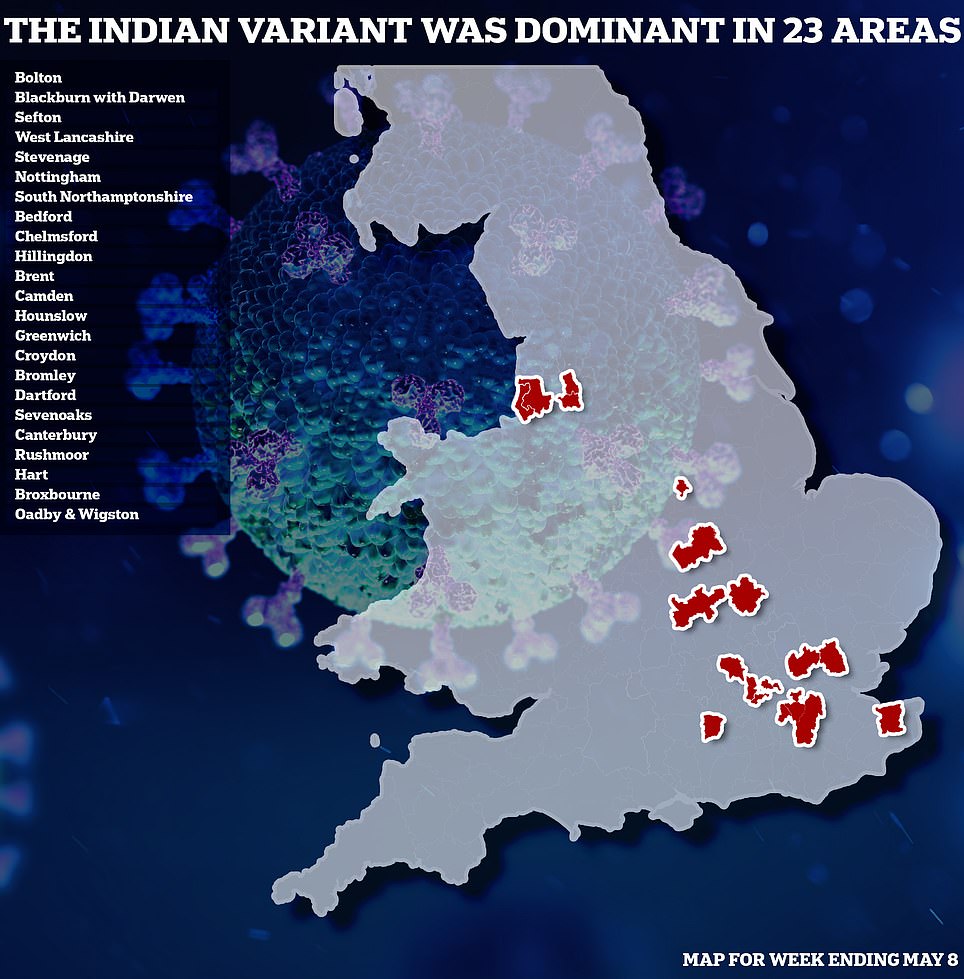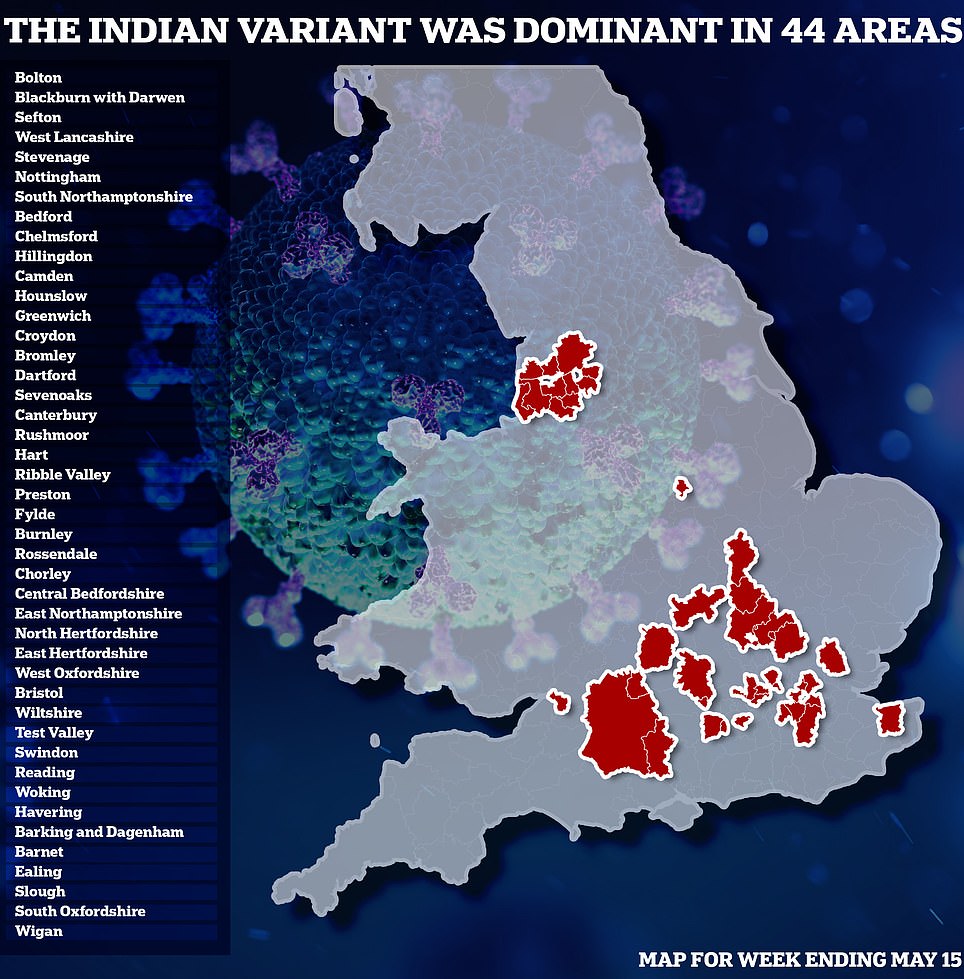Ministers make humiliating climbdown over Indian variant hotspot travel ban and say people should use their own ‘judgement’ as local Tory and Labour leaders say the advice posted online was a ‘mistake’ and and people CAN visit family and go on holiday
- Guidance applies to: Bolton, Blackburn, Kirklees, Bedford, Burnley, Leicester, Hounslow and North Tyneside
- Those living in the eight areas are being told to keep apart from those they don’t live with and meet outdoors
- The guidance appeared on the Government website on Friday without any formal announcement or briefing
- Local MPs and councillors say they were not consulted over the advice, made because of the Indian variant
- It comes amid claims fully jabbed Brits may still have to isolate if they come into contact with a Covid patient
- The threat of having to quarantine will likely undermine plans for England to return to normality next month
- Are you affected by the travel advice? Email: tips@dailymail.co.uk or ring 020 7938 6000
Ministers tonight insisted they are ‘not imposing local restrictions’ and will update guidance on eight Indian variant hotspots after MPs and local chiefs accused them of trying to bring in lockdowns ‘by the back door’.
The Government caused chaos after a change to online guidance banned people from visiting Bolton, Blackburn with Darwen, Kirklees, Bedford, Burnley, Leicester, Hounslow and North Tyneside. The shift went unnoticed for four days before ministers scrambled to explain why there had been no formal announcement.
No10 tried to contain a growing backlash among local Tory and Labour leaders by stressing that the guidance was ‘not statutory’ and that the Government wanted to move away from ‘top-down edicts’ as lockdown eases.
But Greater Manchester Mayor Andy Burnham said the updated online guidance around local restrictions was a ‘fairly major communications error’ which had caused ‘huge amounts of confusion’.
The Department of Health and Social Care has now said it will instead be issuing advice to those living in the eight hotspot areas – but a Government spokesman was clear lockdown measures were not being imposed.
He said: ‘We will be updating the guidance for areas where the new Covid-19 variant is spreading to make it clearer we are not imposing local restrictions. Instead, we are providing advice on the additional precautions people can take to protect themselves and others in those areas where the new variant is prevalent.’
The guidelines include urging people to meet outdoors rather than indoors, staying two metres apart from people not in the same household, and minimising travel in and out of the area.
The Government spokesman added: ‘These are not new regulations but they are some of the ways everyone can help bring the variant under control in their local area.’
In the Commons this afternoon, Vaccines Minister Nadhim Zahawi faced the wrath of MPs over the change in wording of the guidance, with Labour branding the shift ‘upsetting and insulting’.
Shadow health secretary Jon Ashworth slammed the confusing situation, and also condemned Health Secretary Matt Hancock for not having the ‘courtesy’ to come to the House himself.
At a press conference with other local leaders this afternoon, the Tory leader of Bolton Council David Greenhalgh said ministers had now clarified that there are no extra restrictions. ‘As long as they follow the guidance I don’t believe residents in Bolton should be cancelling holidays,’ he said.
The public health directors for Leicester and Tyneside also said they had been told there are ‘no restrictions on travel in or out of each of our areas and it was a mistake to suggest there was’.
It came as the UK recorded 2,493 new infections – a 3.4 per cent rise on last week – and 15 deaths, up on the seven last week.
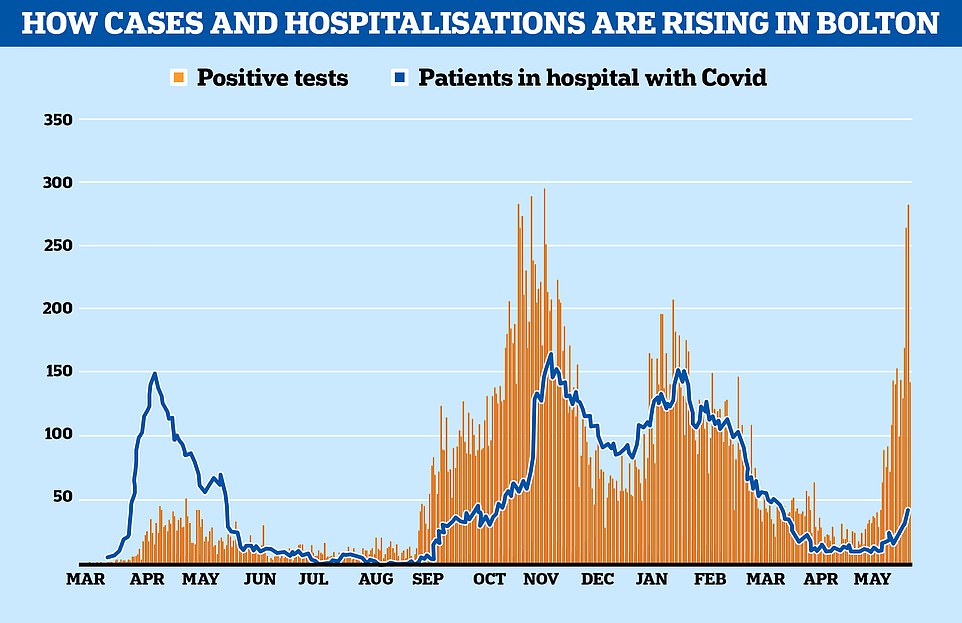
The number of people in hospital with Covid (shown in blue) has typically spiked shortly after cases rise (orange), which appears to be happening again this spring but to a lesser degree thanks to the rollout of the vaccines. The data for the first wave is out of sync because the UK was not routinely testing people for the virus which meant the majority of cases were missed
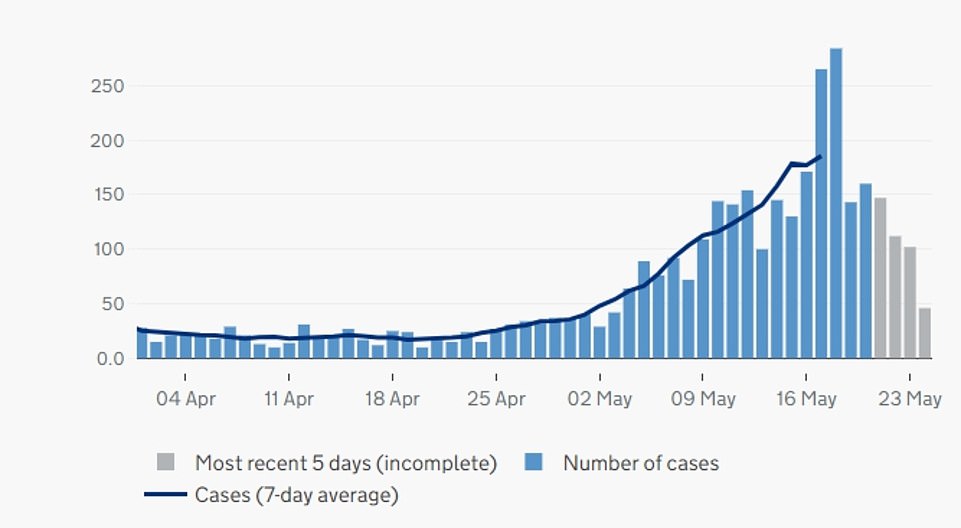
MailOnline’s analysis of the Government’s Covid dashboard data suggests Bolton’s Indian coronavirus variant outbreak may have already peaked (shown as the flat blue line). The rolling seven-day average number of infections was about 185 on May 17, the most recent date for which data is available. The figure had dropped from 177 to 178 the day before. While Bolton is still suffering the highest proportion of cases of anywhere in the country because of the Indian variant, the fact the virus is no longer growing rapidly suggests the town’s outbreak may have already peaked
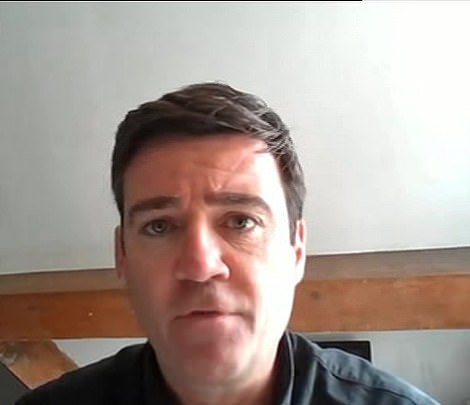
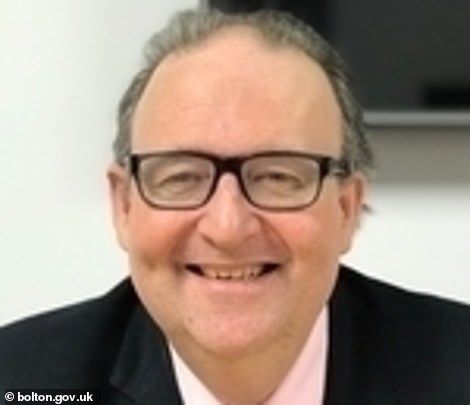
Greater Manchester mayor Andy Burnham (left) and Tory leader of Bolton council David Greenhalgh were among those criticising the online guidance change today

Data shows how big Covid outbreaks are in the eight areas with the travel guidance. The figures show how the rolling seven-day infection rate (the number of cases spotted in a week for every 100,000 people) has changed since the start of the year, with it spiking in Bolton (top right) to above levels seen during the second wave in January. Cases appear much flatter in other areas, including Leicester and Hounslow

Ministers ‘sneaked out’ the advice without any announcement. Local leaders have reacted furiously to the changes, and said they are surprised no one in Whitehall even had the courtesy to let them know about the change
The number of hotspots for the Indian variant, where it accounts for more than 50 per cent of infections, has doubled in just seven days from 23 to 44 local authorities. Separate figures show it is already dominant in the UK

MailOnline’s analysis of the Government’s Covid dashboard data suggests Bolton’s Indian coronavirus variant outbreak may have already peaked (shown as the flat blue line). The rolling seven-day average number of infections was about 185 on May 17, the most recent date for which data is available. The figure had dropped from 177 to 178 the day before. While Bolton is still suffering the highest proportion of cases of anywhere in the country because of the Indian variant, the fact the virus is no longer growing rapidly suggests the town’s outbreak may have already peaked
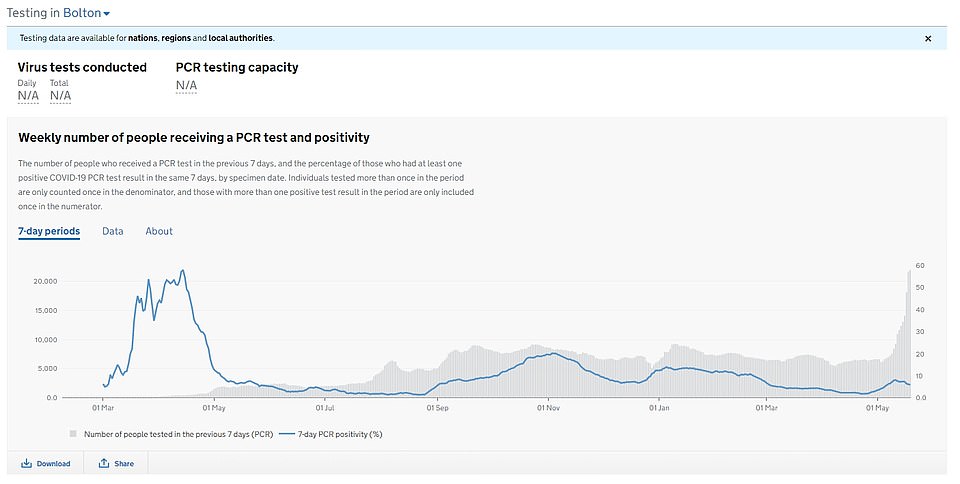
In another promising sign for Bolton, the Government’s Covid dashboard shows the town’s test positivity rate has also been declining in recent days. Currently 5.9 per cent of all PCR swabs done in the borough are positive for Covid, according to data from May 19, down from a peak of 8.1 per cent a week earlier, on May 11. That’s despite almost four times more testing kits being deployed in the Manchester town now than a month ago as part of a surge testing programme to stem the spread of the variant

Bolton currently has an infection rate of more than 400 cases per 100,000 — twenty times the national average — but infections appear to have levelled off (shown on the far right)
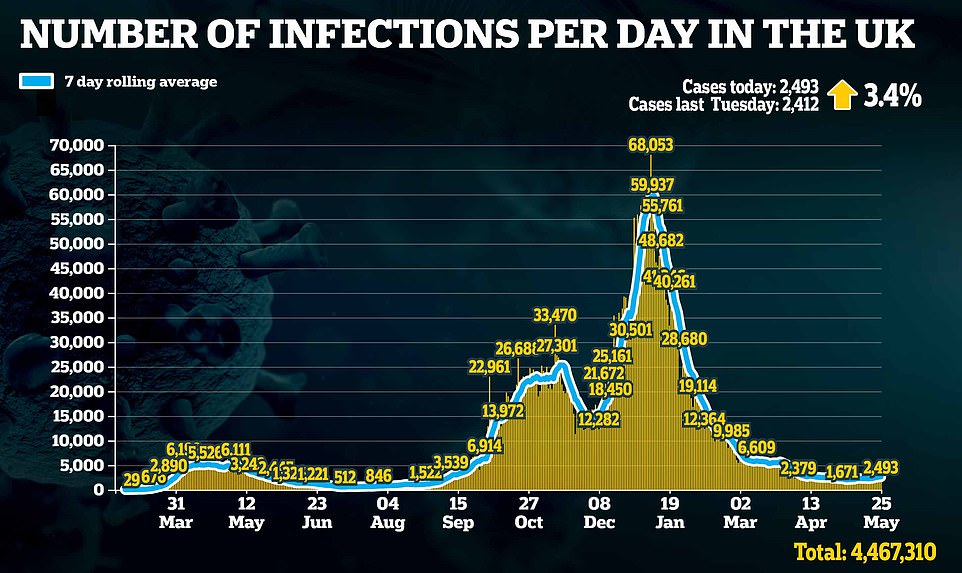
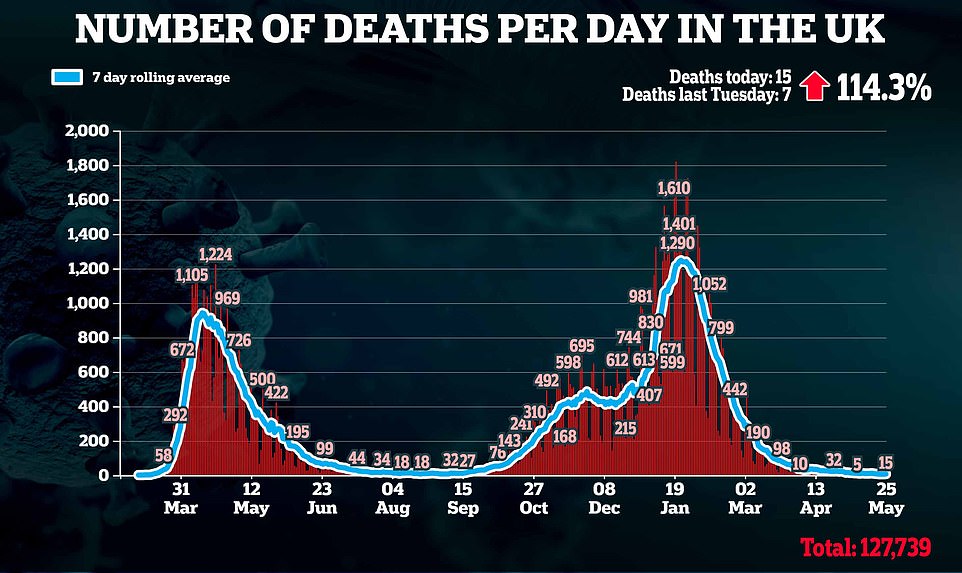
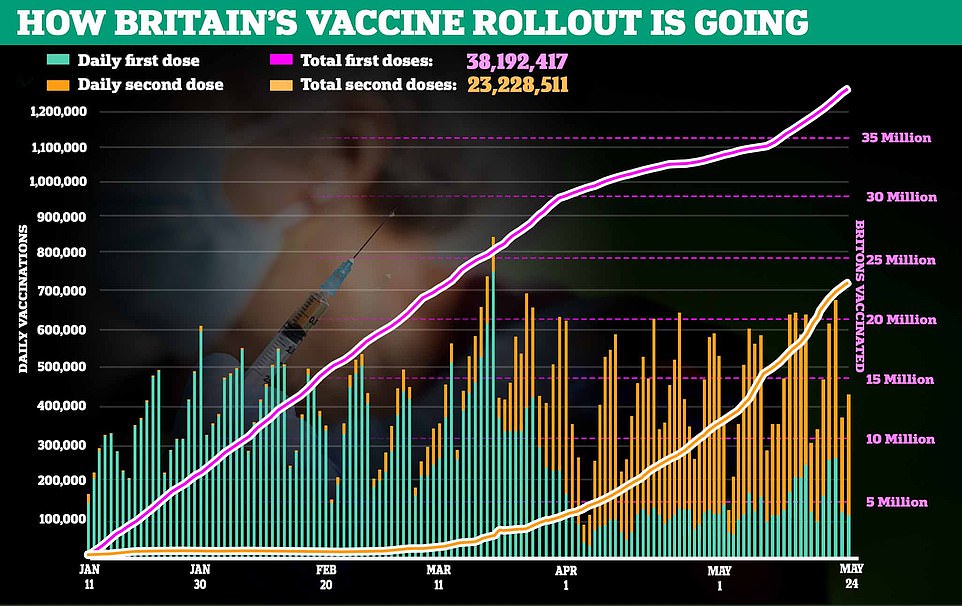

Vaccines minister Nadhim Zahawi faced the wrath of the Commons this afternoon with Labour branding the shift in guidance ‘upsetting and insulting’
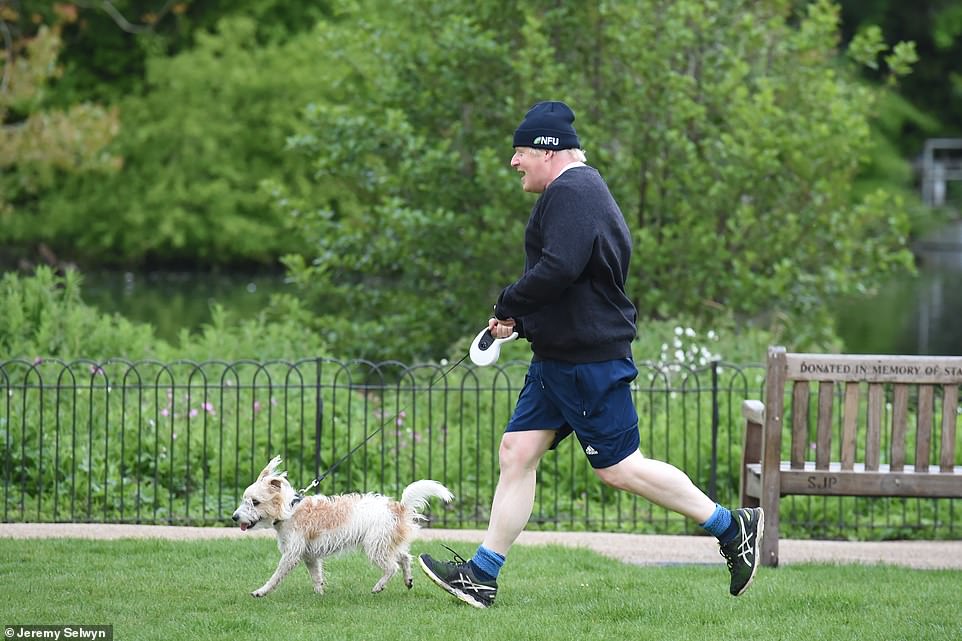
Boris Johnson is pictured jogging in Westminster Park this morning with his dog Dilyn, a Jack Russell cross
Following a meeting about the updated Government guidance, Leicester’s director of public health said officials confirmed ‘there are no restrictions on travel in or out of our areas’ – adding that any suggestions of that sort was a ‘mistake’.
Professor Ivan Browne said: ‘We had an urgent meeting with Government reps and other affected local authorities today, after we became aware that the Government had updated its website to include specific advice around Leicester and some other areas where the new Covid-19 variant has been identified as spreading.
‘These officials confirmed there are no restrictions on travel in or out of each of our areas and it was a mistake to suggest there was.
‘There are no local lockdowns and there is no justification for Leicester to be treated differently to the rest of the country.
‘No-one from the Department of Health and Social Care or Public Health England contacted us about this advice, to explain the rationale behind it or give any other information.
‘As it stands, Leicester has lower rates of the variant than other parts of the country, and we have a plan in place for stepping up our vaccination rate as agreed with the Government last week.’
North Tyneside’s director of public health said there were no restrictions on travel to or from the borough.
Wendy Burke said: ‘Following the national coverage of recently revised guidance, we have met with national officials and confirmed there are no restrictions on travel in or out of North Tyneside.
‘There are no local lockdowns.
‘In areas where the new Covid variant is spreading we are all working together to boost testing and vaccination and to support self-isolation.
‘There are sensible public health precautions people can take as individuals in line with the sorts of advice we have all been following throughout the pandemic.
‘We will keep sharing that and working with national officials to make sure people understand what they need to think about as they go about their daily lives.’
The PM’s official spokesman stressed that the new guidance affecting eight Indian variant hotspot areas was ‘not statutory’.
The spokesman said: ‘It is important to emphasise that this is guidance, these are not statutory restrictions placed on those local areas.
‘We have talked before about where we are at this stage in the pandemic in the UK, where we are able to move away from top-down edicts from the Government and start transitioning to a position where we have moved back to where the public are able to exercise their good judgment, as they have done throughout.
‘We will continue to monitor the situation.’
Earlier, Labour leader Sir Keir Starmer accused ministers of ‘shameful’ behaviour for making the change without telling local people, and demanded they provide clarity ‘fast’. ‘Local lockdowns are the wrong approach for both public health and local economies,’ he said.
Shadow health secretary Jonathan Ashworth said Health Secretary Matt Hancock must urgently explain why the Government is rolling out ‘local lockdowns by the backdoor and hadn’t even bothered to tell us’. Labour will ask ministers about the guidance in an Urgent Question in the House of Commons at 12.30.
Bolton MP Yasmin Qureshi said she was left ‘gobsmacked’ by the change. Blackburn MP Kate Hollern dubbed the extra guidance ‘lockdown-lite’, and newly elected West Yorkshire mayor Tracy Brabin called for Mr Hancock to explain the change to Parliament.
But Cabinet minister Therese Coffey defended the move, telling BBC Radio 4’s Today programme it was ‘sensible’ to issue extra guidance for Indian variant hotspots. The Work and Pensions Secretary said people living in these areas should consider ‘whether it really is essential’ for them to travel, and should limit activities where they risked either passing on or catching the variant.
The Indian variant has already spread to almost half the country, or 151 out of 315 council areas, and is thought to now be the dominant strain in the country having displaced the Kent variant. Estimates suggest it may be around 30 per cent more transmissible but vaccines still work against it.
The updated guidance comes as Boris Johnson and his ministers continue to weigh up the latest evidence on the variant as they decide whether ‘freedom day’ on June 21 – the last step in the PM’s roadmap – will be able to go ahead as planned.
Dr Adam Kucharski, an epidemiologist and member of a SAGE advisory committee, today warned a ‘substantial amount of cases’ of the Indian variant could translate into hospitalisations — which would put some local health services under increased pressure. He added that the final lifting of lockdown restrictions was not ‘inevitable’ because of the rapid spread of the B.1.617.2 strain.
Meanwhile, people are being warned they may be forced to isolate for 10 days if they come into contact with an infected person after June 21 even if they have been fully vaccinated.
When Tory MP Mark Harper asked Mr Zahawi if that was indeed the policy, the minister suggested that within his own family someone had received two doses of vaccine and still contracted the disease.
‘It’s worth waiting until the 14th of June when we will be saying more on this. Suffice to say two things,’ he said.
‘One, even if you’ve had – and I have had this experience in my own family – two doses of either vaccine you still can actually contract covid and therefore you should be isolating and quarantining.
‘We are also looking at ways that contacts of people who may have contracted Covid can be regularly tested instead of isolating.’
The threat of having to quarantine will likely undermine plans to return to normality next month, even for those who have received two Covid jabs.
It could also mean a far slower return to the office for some, as a single infection could still spark a mass quarantine of staff, even if most have been vaccinated. Having a subsequent negative test would not be enough to bring about an end to the quarantine.
Government sources say it is crucial that the contact tracing system stay in place because it is still possible for vaccinated people to pass on coronavirus. One told The Telegraph: ‘There is still a risk of getting the virus and spreading it on.’
Cabinet Office guidance which appears to have been released on May 21 without any fanfare says people should avoid travelling into or out of the eight local authorities where cases of the Indian variant are highest.
It reads: ‘The new Covid variant spreads more easily from person to person. To help stop the spread, you should take particular caution when meeting anyone outside your household or support bubble.
‘In the areas listed, wherever possible, you should try to meet outside rather than inside where possible, keep two metres apart from people that you don’t live with (unless you have formed a support bubble with them). This includes friends and family that you don’t live with, and avoid travelling in and out of affected areas unless it is essential, for example for work (if you cannot work from home) or education.’
It adds residents should also test themselves for the virus twice a week, work from home if possible and get vaccinated.
Sir Keir, MPs and local councillors have blasted the update, and called for clarity over the new restrictions affecting the Indian variant hotspots amid fears they could trigger ‘anxiety and confusion’.
The Labour leader said: ‘Making a major change that will impact so many people without even telling them is utterly shameful. The Government needs to provide clarity, fast. Local lockdowns are the wrong approach for both public health and local economies.
‘The Government is time and again failing to learn lessons. We need proper support to self-isolate, decent sick pay, a working test and trace system and the roll out of the vaccine as quickly as possible.’
Ms Qureshi, Labour MP for Bolton South East and shadow international development minister, said: ‘I was not informed of this and I understand nor was anyone else in Bolton.
‘I’m just gobsmacked. They’re making such an important announcement and they don’t even have the decency to tell us or tell our constituents.
‘The least I would expect is a letter or email from (Matt Hancock) or his office as a matter of courtesy.
‘Further and more importantly, my constituents needed to know. Many will have planned for the long weekend, bought tickets, made arrangements.
‘And it’s still not clear if this is advisory or legally obligatory. This is typical of this Government’s incompetence.’
The Tory MP for Bolton West and Atherton, Chris Green, said he did not find out about the change until 10pm yesterday.
Labour’s Ms Hollern tweeted: ‘On Friday night the Government rolled out lockdown-lite through the back door.
‘The guidance is likely to have major implications on businesses, schools and the hospitality sector and I’m furious that the Government hasn’t bothered to consult the local authorities involved.
‘I strongly oppose the Government’s attempt to introduce new measures by stealth and without consultation.’
Ms Brabin and the leader of the All Party Parliamentary Group on Coronavirus, the Lib Dem MP Layla Moran, have called for Mr Hancock to be hauled before Parliament to explain why the change was made, seemingly without any advice or guidance being sent to local authorities.
‘It’s another example of the Government doing to us without working with us,’ Ms Brabin told BBC Breakfast. ‘It’s caused a lot of confusion. We were only alerted to it by journalists last night, late last night.’
She added: ‘I’m expecting Matt Hancock to come to the Houses of Parliament to explain what’s actually going on.
‘We know that during this pandemic our councils have worked absolutely tirelessly to deliver for our communities. But, if we have an issue here, we need Government to be working with us, not causing more chaos.’
Asked whether this signalled a return to the tier system, she said: ‘If it is, we would like to know. This is part of the problem. We don’t know hot to respond. We don’t know what to advice our citizens. One wonders whether we should be taking this seriously at all.’
Ms Moran said: ‘Simply updating the Government website without an official announcement is a recipe for confusion and uncertainty.
‘Matt Hancock must come before Parliament and make a public statement to explain these new rules. ‘It seems crucial lessons have still not been learnt about the importance of clear messaging during a pandemic.’
Ministers have not ruled out local lockdowns for areas where Covid cases are highest, even after the June 21 ‘freedom day’ when all restrictions are set to be lifted.
Labour’s Ruth Cadbury, the MP for Brentford and Isleworth, slammed ministers for trying to halt travel through the borough of Hounslow, pointing out it has two direct links to Heathrow airport.
‘Keep out of London Borough of Hounslow area?!,’ she said. ‘Does anyone in the Department of Health realise the Piccadilly line and A4 through the borough are the main routes between Heathrow and Central London?
‘Was there any plan to actually discuss this with the council (or even perhaps look at a map)?’
Piling yet more pressure on the Government, North Tyneside’s director of public health Wendy Burke said there had been no indication of any additional restrictions when surge testing was launched last week.
‘We understand that, later, Government guidance around travel in and out of North Tyneside was posted on the Government website,’ she said.
‘This has not been accompanied by any communication to the local authority, local residents or businesses.
‘We have already queried this with the Department of Health and Social Care to seek clarification.’

Department of Health data shows how the number of positive tests being recorded each day has changed in the 10 areas with the biggest outbreaks where the Indian variant is known to be dominant. Top left shows Bolton’s outbreak, which has grown rapidly over the past three weeks. But outbreaks remain flat in other hotspots, such as Preston, Hillingdon and Ealing
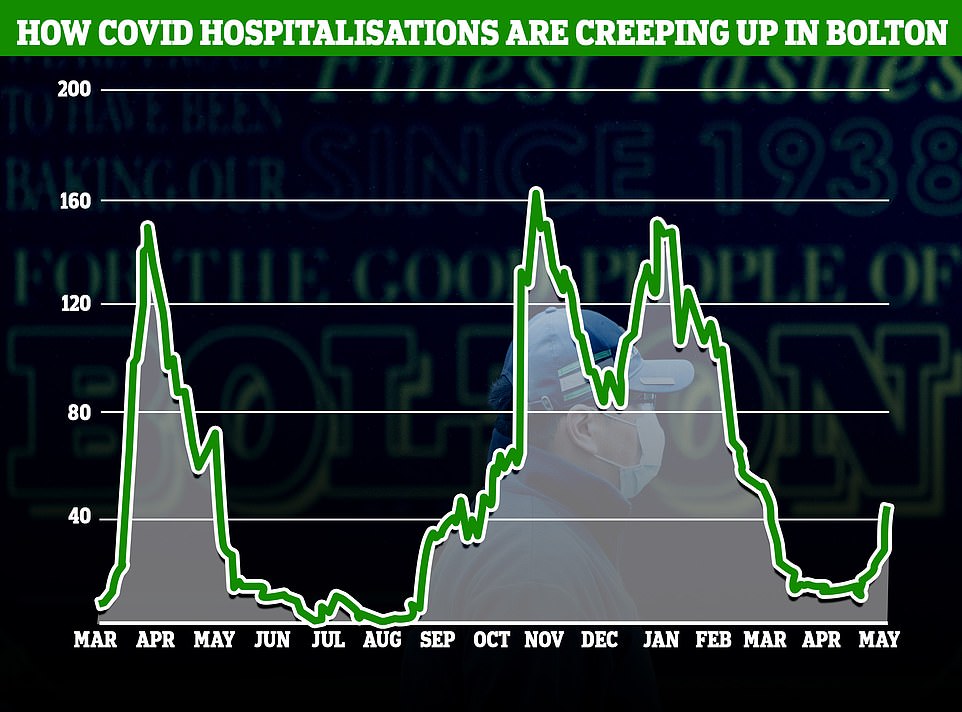
In Bolton, which is recording the highest Covid infection rate in the country due to an outbreak of the Indian variant, hospitalisations have already started to creep up. There are currently 43 Covid patients in Bolton NHS Foundation Trust, according to data from the Government’s Covid dashboard, which is more than triple than at the start of May, when there were 13
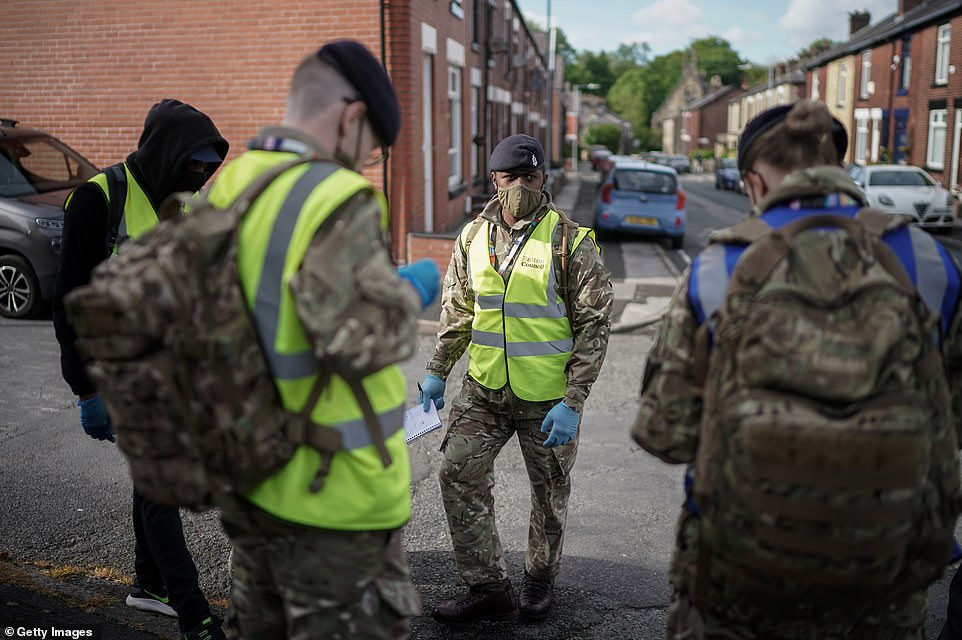
Gunners from the Royal Horse Artillery distribute Covid-19 polymerase chain reaction (PCR) tests to local residents on May 24, 2021 in Bolton

Shadow health secretary Jon Ashworth slammed the confusing situation in exchanges with Mr Zahawi (pictured), and also condemned Matt Hancock for failing to have the ‘courtesy’ of coming to the House himself
Ms Coffey said she was ‘surprised’ to hear that MPs in areas impacted by new guidance around the Indian variant did not feel properly informed.
‘The Prime Minister set out that we need to take extra caution in certain areas regarding the Indian variant,’ she told Sky News. ‘It is good practice to formally put that guidance on the record affecting those communities.
‘We have been working in close contact, so I’m surprised to hear that people think this has come out of the blue – it hasn’t.
‘It is about formalising on the record the guidance which we believe people can and should follow in order to make sure we tackle and don’t have more spread of the Indian variant.’
A Government spokesman said: ‘Working with local authorities, we took swift and decisive action to slow the spread of the B1.617.2 (India) variant by introducing surge testing and bringing forward second doses of the vaccine for the most vulnerable.
‘We provided additional guidance for those living in affected areas when we became aware of the risk posed by the variant, to encourage people to take an extra cautious approach when meeting others or travelling.’
Studies suggest the Indian variant may be around 30 per cent more transmissible than the Kent variant which sparked the second wave in January, but it is still susceptible to vaccine-triggered immunity.
Dr Kucharski, a mathematician and epidemiologist, warned today there could be a ‘substantial increase’ in Covid hospitalisations in some areas over the coming weeks.
‘I think depending on the characteristics of this virus and whether this transmission advantage that we’re seeing would translate into the wider community, you could see a substantial amount of cases translating into hospitalisations,’ he told BBC Radio 4’s Today programme.
‘I think a lot of that would end up being local surges, so we may well end up seeing in specific areas considerable pressure on health systems if these early data sources hold up in terms of what they’re pointing to.
‘But you do have some uncertainty there.
‘The more optimistic end of the scale — if the targeted measures continue to have the effect they seem to be doing, if these features of transmission don’t continue as it reaches the wider community, then we could see a smaller number of cases.
‘But you do get some scenarios looking at the data at face value suggesting some areas could be facing some quite troubling outbreaks.’
The London School of Hygiene and Tropical Medicine academic added that all options needed to be kept on the table ahead of June 21 easing.
‘The roadmap provides that pacing of measures that allows things to be adjusted,’ he said. ‘I think really we have to avoid seeing this as a weather forecast where it’s inevitable that things are going to open [or] it’s inevitable that there’s going to be a wave.’
Bolton in Greater Manchester recorded 451 cases per 100,000 people in the week to 20 May, the highest in England.
The number of people in hospital with coronavirus in Bolton has more than tripled in a fortnight as the Manchester borough grapples with an outbreak of the highly-infectious Indian variant.
Sources say there are currently 43 Covid patients in the town’s NHS trust, compared to 12 that were receiving care on May 10.
Experts fear the pressure on the trust, which looks after the Royal Bolton Hospital, will only get worse as the infection rate climbs.
Bolton is recording more than 400 Covid cases per 100,000 people – twenty times the national average – following a period of exponential growth of the Indian variant in the last month. It takes several weeks for cases to turn into hospitalisations due to the lag between someone catching and falling seriously ill with Covid.
However, Number 10 has said the ‘majority’ of people being hospitalised with the disease currently are either unvaccinated or have not been for both jabs.
Analysis by Public Health England has found two doses of AstraZeneca or Pfizer‘s jab provide a similar level of protection from the Indian variant as they do for the Kent version, which has raised hopes that hospital and death rates will not reach the peaks of previous waves.
Meanwhile, data published yesterday showed the Indian variant spiralling in Bolton is now dominant in nearly 15 per cent of authorities in England – almost twice as many as the previous week.
Analysis of samples from people infected with Covid in the week up to May 15 also shows that the B.1.617.2 strain had spread to 151 out of England’s 314 local authorities.
The mutant virus had overtaken the previously-dominant Kent variant in 44 places, up from 23 the week prior.
It is now behind behind 90 per cent of Covid infections in Blackburn and eight in ten in the hotspots of Bolton, Sefton, Bedford and Croydon.
The places where the Indian strain overtook the Kent variant in the most recent week were: Ribble Valley, Preston, Fylde, Burnley, Rossendale, Chorley, Central Bedfordshire, East Northamptonshire, North Hertfordshire, East Hertfordshire, West Oxfordshire, South Oxfordshire, Bristol, Swindon, Wiltshire, Test Valley, Reading, Woking, Slough, Havering, Barking and Dagenham, Barnet, Ealing.
It is still dominant in: Bolton, Blackburn with Darwen, Sefton, West Lancashire, Stevenage, Nottingham, South Northamptonshire, Bedford, Chelmsford, Dartford, Sevenoaks, Canterbury, Rushmoor, Hart, Hillingdon, Camden, Hounslow, Greenwich, Croydon and Bromley.
But it is no longer the dominant strain in Oadby and Wigston, Broxbourne and Brent which may be down to very low case numbers in these areas.
Bolton has the highest infection rate out of local authorities suffering outbreaks of the Indian variant (434 cases per 100,000 people) which has more than doubled over the past week.
Data suggests that two per cent of people in one neighbourhood of the borough tested positive for the virus last week.
Blackburn with Darwen had the second largest outbreak (215.1), and Bedford had the third largest (142.5).
They were followed by new hotspots Burnley (60.7), Rossendale (57.4), Chorley (55.8) and Preston (48.9).
Indian variant hotspot Hounslow had the highest Covid infection rate in London (47.5). It was followed by Hillingdon (39.1) and Ealing (35.7).
For comparison, England’s average is 21.3 per 100,000 and has remained around this level since mid-April.
PHE’s latest breakdown shows 46.2 per cent of Covid cases were the Kent variant in the week to May 10, but 53.8 per cent were down to other variants. It is thought the first majority were B.1.617.2.
Professor Paul Hunter, an expert in infectious diseases at the University of East Anglia, told MailOnline that the Indian strain was likely already the dominant strain of the virus across the UK because the Sanger data is weeks out of date.
He noted that the variant is spreading in areas that were hardest hit at earlier stages of the pandemic, suggesting that social and other mixing factors were contributing to the outbreaks, rather than purely the infectiousness of the strain.
‘Covid is retreating to its strongholds of last summer, looking at the latest map which is already out of data,’ he said.
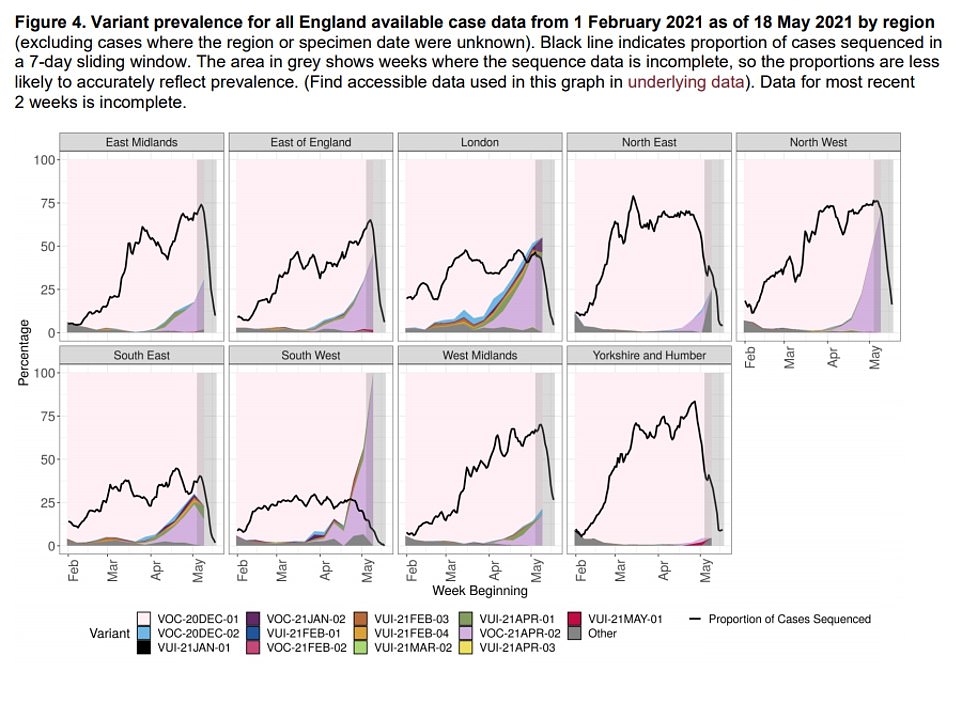
Data from Public Health England shows the prevalence of variants across all the regions of England, with the Indian variant (light purple) compared to the Kent variant (white/pink). Data shows B.1.617.2 is now dominant in the North West, making up around 70 per cent of all sequenced cases. The proportion of samples analysed in a lab is shown by the black line. The sharp drop off is down to the lag in getting samples analysed and not because of a huge reduction in swabs being checked
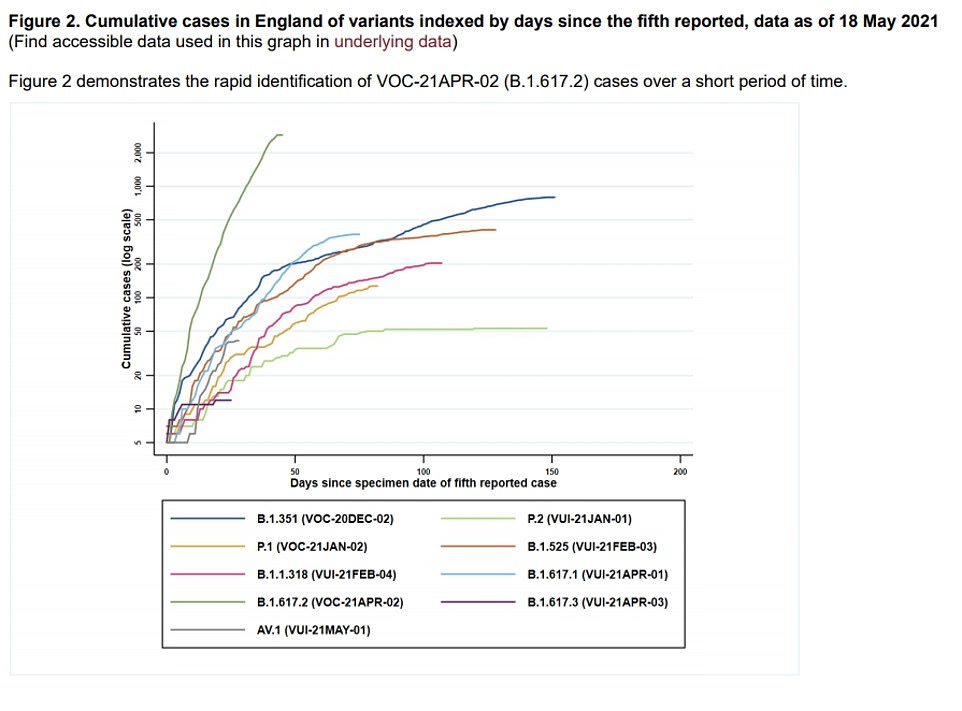
Data also shows how quickly the different variants have grown in England, with the Indian variant (green) spreading rapidly. The South African variant is coloured blue
‘The areas where Covid has traditionally found it easier to spread are the same areas where the variant is finding it easier to spread.
‘And that is not surprising because of deprivation, inner city, more crowded dwelling, multi-generational occupancy.’
He added that as cases rose in the coming weeks it was inevitable that hospitalisations and deaths from the virus would also go up, but that he did not know by how much.
‘It will be somewhere between being manageable and close to Armageddon,’ he said. ‘But I’m not sure which extreme it will be closer to.’
It came after one of the country’s top scientists suggested today that Britain could officially be freed from the grips of the Covid crisis if the current vaccines work as expected against the Indian variant.
Oxford’s Professor Andrew Pollard said the pandemic in the UK could be ‘over’ if the vaccines cut the risk of hospitalisation and death as well in the real world as analysis suggests.
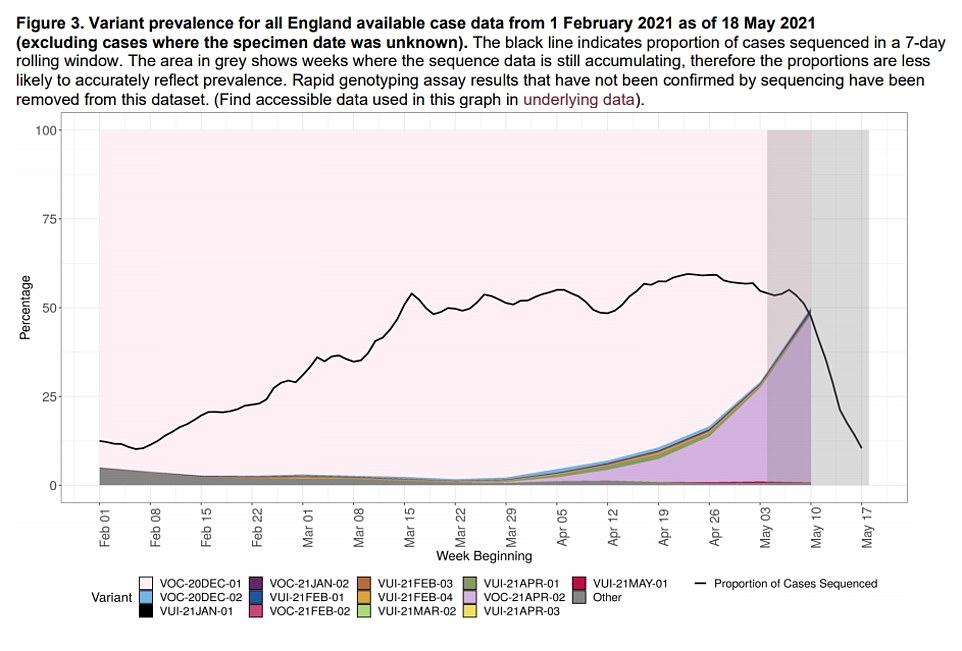
National data also shows how quickly the Indian variant (purple) has spread, making up around half of all new cases reported across the country. The Kent variant is shaded pink. The proportion of cases being sequenced is shown by the black line
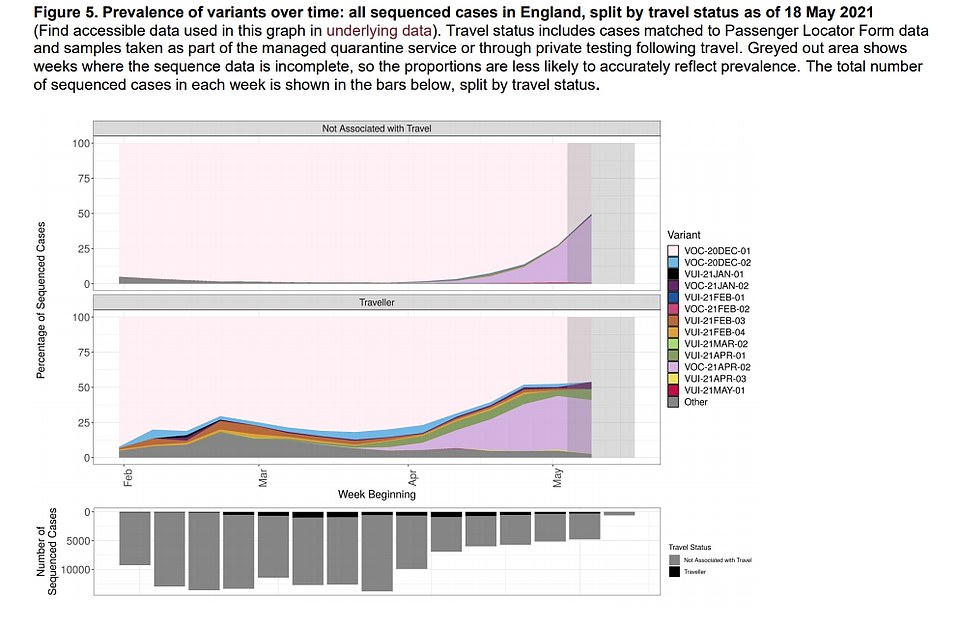
PHE analysis also revealed how the Indian variant is spreading quickly in the community (top graph, Indian variant is purple). The middle graph shows the proportion of cases made up by travellers. The bottom graph shows the amount of cases that were sequenced in different weeks. It can take several weeks for samples to be thoroughly analysed, meaning there is a lag in the data

Separate figures also show the number of suspected reinfections over time, which are broken down into different types of the coronavirus. The purple area highlights reinfections seen in people who have caught the Indian variant
Because the vaccines were shown to be highly effective at stopping people falling ill with Covid in the first place, PHE said they are likely to be even better at preventing hospitalisation and deaths.
Professor Pollard said that a few more weeks were needed to firm up this claim, but he added that, traditionally, vaccines offer ‘much, much higher’ protection against hospitalisation and death than mild infection.
However, both Pfizer and AstraZeneca’s jabs were only 33 per cent effective at blocking symptoms of the Indian strain three weeks after one dose, compared to 50 per cent against the Kent variant. Officials say it highlights the importance of getting both injections.
Professor Pollard told BBC Radio 4’s Today programme: ‘If the current generation of vaccines are able to stop people going into hospital, whilst there is still mild infections, people are getting the common cold with the virus, then the pandemic is over.
‘Because we can live with the virus, in fact we are going to have to live with the virus in one way or another, but it doesn’t matter if most people are kept out of hospital because then the NHS can continue to function and life will be back to normal. We just need a little bit more time to have certainty around this.’
Ministers say England is on track for all restrictions to be dropped as planned on June 21, despite fears the rapid spread of the Indian variant would jeopardise ‘freedom day’.
Armed with the PHE evidence vaccines work against B.1.617.2, the boss of the UK’s Health Security Agency argued the prospect of all Covid restrictions being lifted next month was ‘looking good’. Health Secretary Matt Hancock also called the findings ‘groundbreaking’.
But some scientists are not convinced by No10’s ever-growing optimism, saying May 17’s relaxation of lockdown measures may trigger a rapid spike in cases given that the Indian variant is ‘on the cusp’ of becoming dominant in England.
Professor Christina Pagel, a member of the Independent SAGE panel of scientists, said ministers should consider ‘rolling back step three of the roadmap’ if cases continue to rise this week. Department of Health figures show the number of positive tests has jumped by 11 per cent over the past seven days.
Hospitalisations and deaths across the UK are at their lowest levels since the crisis began, with just six fatalities a day and fewer than 100 hospital admissions, on average. For comparison, around 1,300 deaths were occurring every day at the peak of the second wave in January.
However, the number of infected patients occupying beds at the major NHS trust in Bolton — one of the country’s hotspots for the Indian variant — has continued to creep up over the past week.
There is no proof the Indian variant is more lethal than older strains of the coronavirus but data shows it is more transmissible than the Kent type, which triggered Britain’s devastating second wave before vaccines were rolled out.
Experts believe B.1.617.2 is 30 per cent more infectious than B.1.1.7 — the name for the Kent strain — but won’t get any concrete data for at least another week.

